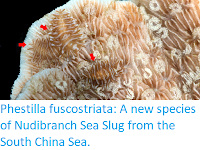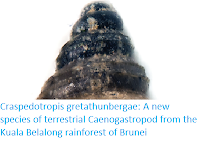Miniaturisation presents both new opportunities and novel challenges to Animal species, in so far as a small size often enables species to access resources and ecological niches unavailable to similar but larger species. The smallest parasitic Wasps specialise in targeting the eggs of other small Insect species, and can have adult sizes as small as 0.3 mm, enabling them to utilise a food source unavailable to larger species. Tiny Mites and Feather-wing Beetles are able to live in soil where the only food particles are to small to sustain larger species, and hide in cracks and crevices also beyond the reach of bigger Arthropods. The size of the space between soil particles probably also controls the lowest possible size for Snails living in these environments; with the accessibility of a space given by the ability of the Snail to pull its shell through gaps, since this is the only rigid part of its body. The past few years have seen the description of several new Snail species, each of which has replaced the one before as the smallest known terrestrial Snail.
In a paper published in the journal Contributions to Zoology on 5 January 2022, Barna Páll-Gergely of the Plant Protection Institute at the Centre for Agricultural Research, Adrienne Jochum of the Naturhistorisches Museum der Burgergemeinde Bern, the Institute of Ecology and Evolution at the University of Bern, and the Senckenberg Forschungsinstitut und Naturmuseum, Jaap Vermeulen and Katja Anker of JK Art and Science, András Hunyadi of Budapest, Aydin Örstan of the Section of Mollusks at the Carnegie Museum of Natural History, and Ábel Szabó of the Lithosphere Fluid Research Laboratory at Eötvös University, describe two new species of Land Snail from Laos and Vietnam, both of which are smaller than any previously described species, making the smaller of the two the new official smallest known species.
Both new species belong to the genus Angustopila, a genus which also contains two other species that have held the title of 'Smallest Land Snail' since 2015.
The first of these new species is named Angustopila coprologos, meaning 'dung-gatherer' in Greek, in reference to the mud granules, assumed by Páll-Gergely et al. to be faeces, which the species places upon its shells. This species is known only from 19 empty shells, which were found in a limestone gorge in Bolikhamsai Province, Laos, following a season of heavy rain, and are thought to have been washed down from crevices in the limestone cliffs above.
Angustopila coprologos has a strongly depressed-globular shell with a wide umbilicus, and strong spiral sculpture consisting of a series of coarse elevations (flat-topped beads) in a chain-like pattern and four well-developed teeth around the aperture to its shell. The specimens found were 0.66–0.76 mm high and 0.49–0.58 wide.
The habit of placing granules of mud or other debris on their shells is quite common in terrestrial Snails, with many distantly related species doing this. It is generally thought that the Snails do this for camouflage purposes, enabling them to blend in better with their environment. However, Angustopila coprologos is thought to live in crevices in limestone cliffs, possibly around the root systems of cliff-dwelling Plants, where it is difficult to see how such camouflage would be useful. The grains on the shell of Angustopila coprologos tend to accumulate in the umbilicus of the shell, suggesting that they are placed spirally and are overgrown as the shell grows, Páll-Gergely et al. suggest that these particles might be the faeces of the Snail, essentially mud that has been passes through the gut of the Snail to extract micro-organisms and other food, then bound together with mucus to make a pellet which is attached to the shell, and that this might be a means of signalling to other members of the species in some way, or possibly help the Snails conserve water in what can be a dry environment.
The second new species described is named Angustopila psammion, where 'psammion' means a grain of sand in Greek. The species is described from 416 empty shells collected in small sediment deposits along the walls of a dry cave (Cap La Cave in Quang Ninh Province, Vietnam), in complete darkness. Páll-Gergely et al. assume that the sediment had fallen in through crevices in the rock, because it contains a species-rich assemblage of bleached, opaque shells of surface-dwelling terrestrial Gastropods, although the shells of Angustopila psammion appear fresh and are probably local to the environment where they were found rather than washed in from elsewhere.
The shells of Angustopila psammion are depressed-globular shell with dome-shaped spires, thick spiral striae, and kidney-shaped apertures with a single parietal denticle not reaching the parietal callus. The shells range from 0.6 to 0.68 mm in height and from 0.46 to 0.57 mm in width, making it the smallest yet reported species of terrestrial Gastropod.
In 2015 a team led by Barna Páll-Gergely reported the discovery of Angustopila dominikae from southern China, which had a maximum shell height of 0.86 mm, making it the smallest known terrestrial Gastropod at that time. However, only two months later another team, led by Jaap Vermeulen, reported an even smaller Snail, Acmella nana, from Sabah Province on Malaysian Borneo, with a shell height of 0.60–0.79 mm, and a shell width of 0.50–0.60 mm. In 2016, Mohammad Effendi Marzuki and Jun Kitt foom described an even smaller species, Arinia micro, from Perak State in Peninsular Malaysia, with a shell height of 0.80–0.90 mm, and a shell width og 0.34–0.35 mm. Most recently, a team led by Pongrat Dumrongojwattama reported the discovery of Angustopila pallgergelyi, with a shell width of 0.76–0.85 mm and a shell height of 0.59–0.71 mm, from eastern Thailand.
Páll-Gergely et al. note, however, that while Angustopila psammion is the smallest Snail in terms of height, Arinia micro is considerably narrower, and could potentially fit through smaller gaps. This suggests that height might not, alone, be a suitable measure of the smallest species, and a slightly more analytical method might be needed. To do this they found the smallest clearly adult specimen of each species (the aperture teeth do not develop in these Snails until the Animal is fully grown), and took the average of the height and width of these specimens as a measure of smallness. This produced a result of 54.5 mm for Angustopila psammion, making it the smallest species, and 59.5 for Acmella nana, the second smallest species.
See also...



Follow Sciency Thoughts on Facebook.
Follow Sciency Thoughts on Twitter.







